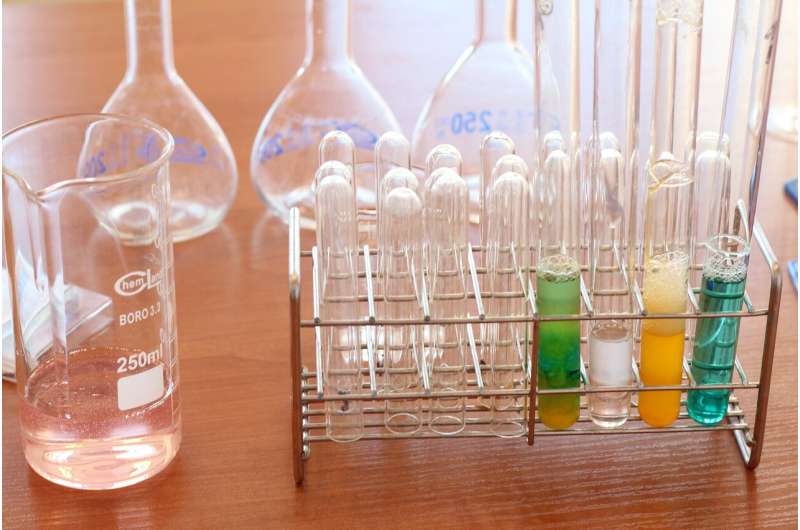Scientists discover new 'origins of life' chemical reactions

Four billion years ago, the Earth looked very different than it does today, devoid of life and covered by a vast ocean. Over the course of millions of years, in that primordial soup, life emerged. Researchers have long theorized how molecules came together to spark this transition. Now, scientists at Scripps Research have discovered a new set of chemical reactions that use cyanide, ammonia and carbon dioxide—all thought to be common on the early earth—to generate amino acids and nucleic acids, the building blocks of proteins and DNA.
"We've come up with a new paradigm to explain this shift from prebiotic to biotic chemistry," says Ramanarayanan Krishnamurthy, Ph.D., an associate professor of chemistry at Scripps Research, and lead author of the new paper, published July 28, 2022 in the journal Nature Chemistry. "We think the kind of reactions we've described are probably what could have happened on early earth."
In addition to giving researchers insight into the chemistry of the early earth, the newly discovered chemical reactions are also useful in certain manufacturing processes, such as the generation of custom labeled biomolecules from inexpensive starting materials.
Earlier this year, Krishnamurthy's group showed how cyanide can enable the chemical reactions that turn prebiotic molecules and water into basic organic compounds required for life. Unlike previously proposed reactions, this one worked at room temperature and in a wide pH range. The researchers wondered whether, under the same conditions, there was a way to generate amino acids, more complex molecules that compose proteins in all known living cells.
In cells today, amino acids are generated from precursors called α-keto acids using both nitrogen and specialized proteins called enzymes. Researchers have found evidence that α-keto acids likely existed early in Earth's history. However, many have hypothesized that before the advent of cellular life, amino acids must have been generated from completely different precursors, aldehydes, rather than α-keto acids, since enzymes to carry out the conversion did not yet exist. But that idea has led to debate about how and when the switch occurred from aldehydes to α-keto acids as the key ingredient for making amino acids.
After their success using cyanide to drive other chemical reactions, Krishnamurthy and his colleagues suspected that cyanide, even without enzymes, might also help turn α-keto acids into amino acids. Because they knew nitrogen would be required in some form, they added ammonia—a form of nitrogen that would have been present on the early earth. Then, through trial and error, they discovered a third key ingredient: carbon dioxide. With this mixture, they quickly started seeing amino acids form.
"We were expecting it to be quite difficult to figure this out, and it turned out to be even simpler than we had imagined," says Krishnamurthy. "If you mix only the keto acid, cyanide and ammonia, it just sits there. As soon as you add carbon dioxide, even trace amounts, the reaction picks up speed."
Because the new reaction is relatively similar to what occurs today inside cells—except for being driven by cyanide instead of a protein—it seems more likely to be the source of early life, rather than drastically different reactions, the researchers say. The research also helps bring together two sides of a long-standing debate about the importance of carbon dioxide to early life, concluding that carbon dioxide was key, but only in combination with other molecules.
In the process of studying their chemical soup, Krishnamurthy's group discovered that a byproduct of the same reaction is orotate, a precursor to nucleotides that make up DNA and RNA. This suggests that the same primordial soup, under the right conditions, could have given rise to a large number of the molecules that are required for the key elements of life.
"What we want to do next is continue probing what kind of chemistry can emerge from this mixture," says Krishnamurthy. "Can amino acids start forming small proteins? Could one of those proteins come back and begin to act as an enzyme to make more of these amino acids?"
In addition to Krishnamurthy, authors of the study, "Prebiotic Synthesis of α-Amino Acids and Orotate from α-Ketoacids Potentiates Transition to Extant Metabolic Pathways," are Sunil Pulletikurti, Mahipal Yadav and Greg Springsteen.
More information: Ramanarayanan Krishnamurthy, Prebiotic synthesis of α-amino acids and orotate from α-ketoacids potentiates transition to extant metabolic pathways, Nature Chemistry (2022). DOI: 10.1038/s41557-022-00999-w. www.nature.com/articles/s41557-022-00999-w
Journal information: Nature Chemistry
Provided by The Scripps Research Institute





















